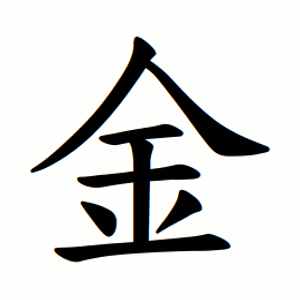金
- metal;
- iron;
- gold;
- amount of money;
By extension, it means one of the precious metals, 'gold.' Furthermore, it can also mean 'money.'
Etymology
金 is a pictogram originally representing the shape of a mold used to cast tools and weapons made of metal such as axes and spears.
There are many theories about its exact origin, but a neat explanation is that it is a phono-semantic compound of 今 (pronounced "jin," meaning "now") for sound and 玉 (jade) for meaning.
Another view suggests it is composed of 今 (phonetic) and 土 (earth) as semantic.
The two dots inside the 王 (king) component originally appeared separately on the left side in bronze script but were later moved inside in the small seal script.
Historically, before the Warring States period in ancient China, 金 referred to copper (銅, tong), since copper was easy to melt and ore was easily found. Later, as metallurgy developed to include other metals, the meaning expanded to metals in general. Eventually, as copper’s status as a precious metal declined, 金 shifted to primarily mean gold, and a new character, 銅, was created for copper.
Usage in Korean
When used as a surname or some place names, it is read as "김."
In other contexts, it is read as "금."
金 is a key radical used to form characters mostly related to metals and minerals.
All metallic elements in the periodic table in Chinese use 金 as a radical.
Alternative forms
Similar shape characters
Characters with 金
Words that derived from 金
- 군자금(軍資金)–military funds
- 금고(金庫)–safety; strongbox; finance company; credit cooperative; credit union
- 금관(金冠)–gold crown
- 금붕어(金붕어)–goldfish
- 금색(金色)–golden color
- 금속(金屬)–metal
- 금속 활자(金屬活字)–metal type
- 금요일(金曜日)–Friday
- 금융(金融)–finance
- 금전(金錢)–gold coin; money
- 기금(基金)–fund
- 당첨금(當籤金)–prize money
- 요금(料金)–fare; fee; charge
- 임금(賃金)–wage; pay
- 자본금(資本金)–capital
- 황금(黃金)–gold
- 金 (C)
- ⿱ 𫢉 䒑
